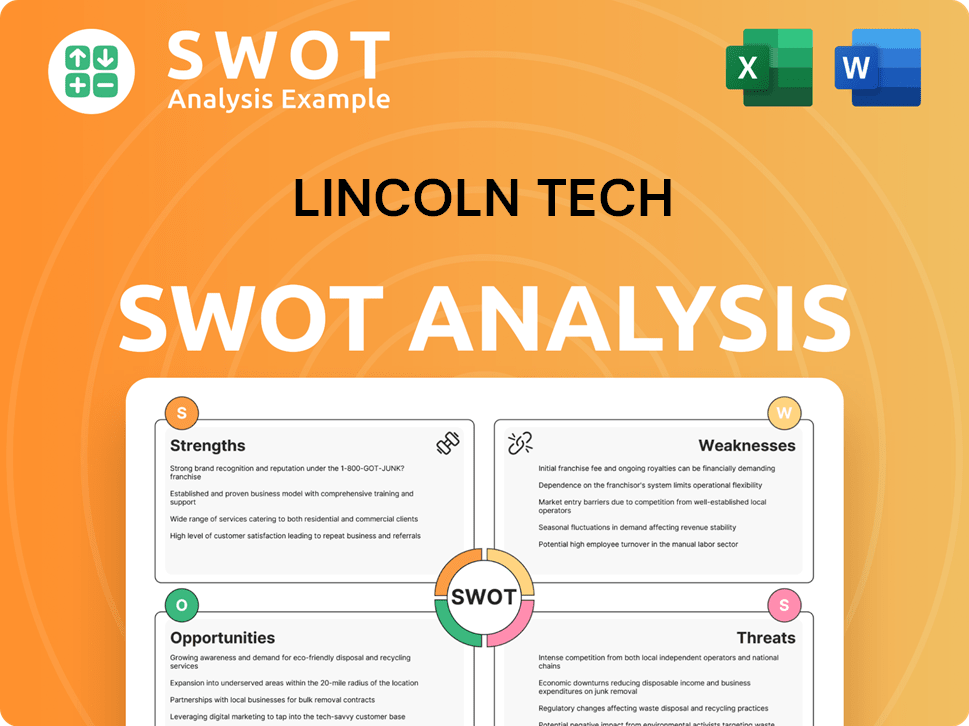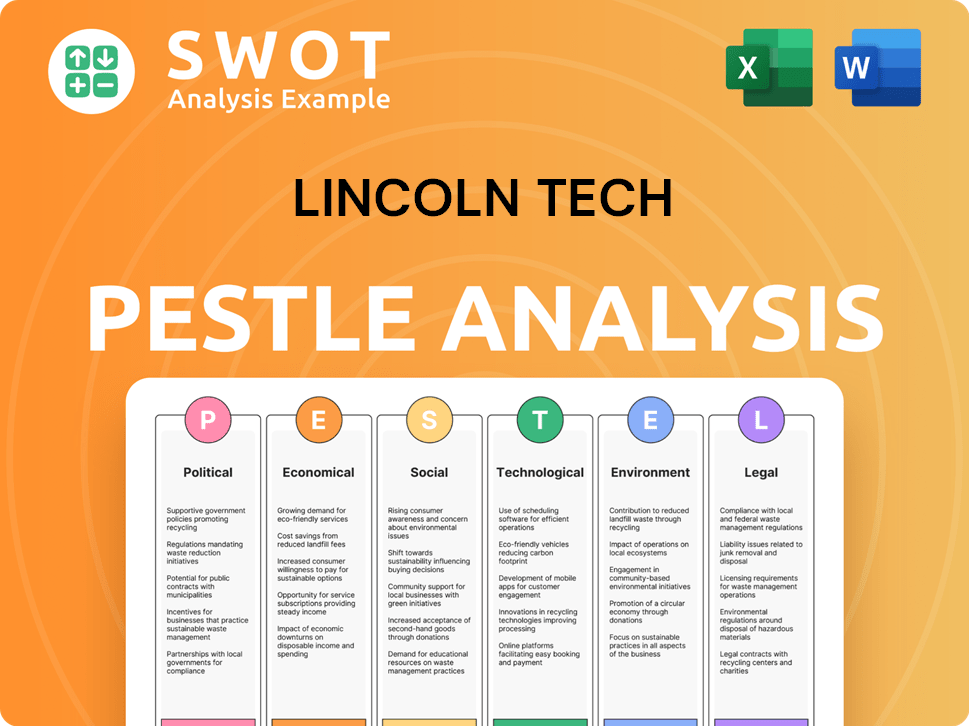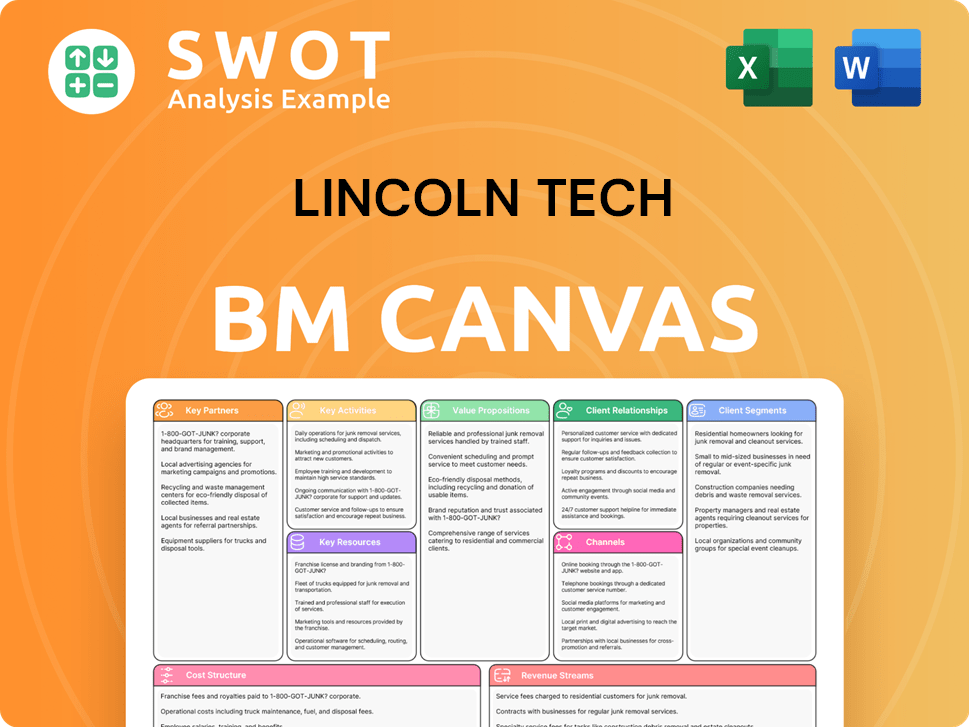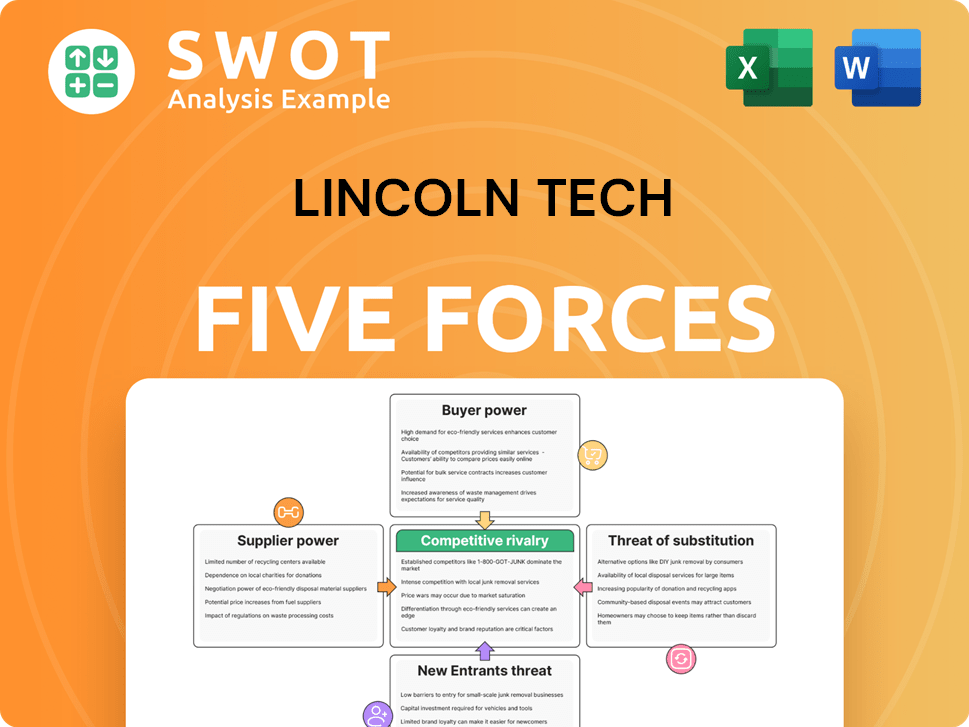Lincoln Tech Bundle
Who is the Ideal Student for Lincoln Tech?
Embark on a deep dive into the heart of Lincoln Tech's strategy: understanding its customer demographics and target market. Since 1946, Lincoln Tech has been a pivotal player in career-oriented education, evolving to meet the demands of a changing workforce. With a 16% revenue increase in 2024, understanding their customer base is key to their continued success.

This analysis will explore the Lincoln Tech SWOT Analysis, student profile, and ideal customer, examining their age range, geographic location, and specific needs. We'll uncover how Lincoln Tech attracts and supports its students, ensuring they are well-prepared for careers in automotive technology, healthcare, and skilled trades. By understanding the factors influencing enrollment and career goals, we can appreciate Lincoln Tech's ability to address the skills gap and provide tangible benefits to its students.
Who Are Lincoln Tech’s Main Customers?
Understanding the customer demographics and target market is crucial for any business, and for a technical school like Lincoln Tech, it's essential to know who they serve. Lincoln Tech primarily focuses on two main groups of students: recent high school graduates and working adults. As a business-to-consumer (B2C) educational service provider, the company tailors its programs to meet the needs of these individuals, who are typically seeking accelerated programs that lead directly to employment in high-demand fields.
While detailed breakdowns by age, gender, and income aren't always available in public reports, the focus on 'middle-skill jobs' provides insight into the target demographic. These are individuals interested in practical, hands-on training for essential occupations. The programs offered include automotive technology, healthcare services, skilled trades (such as welding, HVAC, and electrical), business and information technology, and culinary arts. This customer profile helps define the ideal customer for the institution.
The customer demographics for these programs are heavily influenced by workforce demands. The company's strategic decisions, such as divesting its cosmetology campus, reflect a focus on higher-margin opportunities and the evolving needs of the job market. The demand for its core programs remains high, driven by the growing interest in skilled trades training across the nation, as shown in the Q1 2025 results with a 20.9% increase in student starts.
The student profile at Lincoln Tech is diverse, encompassing recent high school graduates and adult learners. These students are united by a common goal: to gain practical skills and enter the workforce quickly. They are often seeking an alternative to a traditional four-year college degree, focusing instead on career-oriented programs.
The ideal customer for Lincoln Tech is someone motivated to learn a trade or skill, and eager to start a new career. They are often looking for programs that offer hands-on training and industry-recognized certifications. The target market includes individuals who are ready to invest in their future through focused, practical education.
The target market for Lincoln Tech is primarily centered around individuals interested in skilled trades and healthcare. This includes those seeking training in automotive technology, healthcare services, skilled trades (welding, HVAC, electrical), business and information technology, and culinary arts. The company's strategic focus aligns with the growing demand for skilled workers.
Lincoln Tech addresses the specific needs of its customers by offering accelerated, career-focused programs. These programs are designed to provide practical skills and industry-recognized certifications. The curriculum is often developed in collaboration with industry partners to ensure that graduates are well-prepared for the workforce.
Students at Lincoln Tech benefit from a variety of advantages, including accelerated programs, hands-on training, and career services. The focus is on providing practical skills that lead to direct employment in high-demand fields. The curriculum is designed to meet the needs of the current job market, ensuring graduates are well-prepared for their chosen careers.
- Career-focused programs
- Hands-on training
- Industry-recognized certifications
- Career services and job placement assistance
Lincoln Tech SWOT Analysis
- Complete SWOT Breakdown
- Fully Customizable
- Editable in Excel & Word
- Professional Formatting
- Investor-Ready Format

What Do Lincoln Tech’s Customers Want?
Understanding the customer needs and preferences is crucial for the success of any educational institution. For Owners & Shareholders of Lincoln Tech, this involves a deep dive into the motivations and expectations of their students. The primary goal is to align program offerings with the career aspirations and practical needs of individuals seeking vocational training.
Students are drawn to programs that offer a direct pathway to employment. They prioritize accelerated training programs designed to quickly equip them with the skills needed for high-demand industries. This focus is evident in the curriculum design, which emphasizes hands-on experience and industry-recognized certifications.
The core of the customer base is driven by the desire for rapid workforce entry, career advancement, and skill development. The decision-making process is often influenced by the direct applicability of training to employment opportunities and the potential for increased earning potential. For example, the average tech salary in Lincoln, Nebraska, is approximately $85,000 in 2025, with roles like software development managers earning around $126,420, highlighting the financial incentives for career-oriented training.
Customers seek practical, hands-on learning experiences that replicate real-world working environments using professional-grade equipment. This approach is reflected in the curriculum, which integrates industry-preferred licensing and certifications.
A significant psychological driver is the desire for a clear career path and a solution to the 'skills gap' in the American workforce. Middle-skill jobs constitute a substantial portion of the labor market.
A key pain point addressed is the financial barrier to education. The company made over $20 million in trade school scholarships and grants available nationally for students in 2024 to mitigate financial hurdles.
Feedback from employers and industry associations directly influences curriculum development, ensuring training programs address existing skill gaps and needs. This helps in tailoring programs to meet industry demands.
Marketing and program features emphasize the value of vocational education and highlight job placement rates, which are high for many programs. This includes the Lincoln 10.0 hybrid teaching model, offering flexibility for students.
The Lincoln 10.0 hybrid teaching model contributes to improved marketing efficiencies with a 20% reduction in cost per student start.
The target market for Lincoln Tech is defined by specific needs and preferences, including the desire for practical skills, career advancement, and manageable education costs.
- Rapid Workforce Entry: Programs designed for quick entry into high-demand fields.
- Hands-On Training: Practical learning experiences with professional-grade equipment.
- Career-Focused Curriculum: Training aligned with industry needs and employer feedback.
- Financial Accessibility: Scholarships and grants to reduce financial barriers.
- Flexible Learning Options: Hybrid models to accommodate diverse student needs.
Lincoln Tech PESTLE Analysis
- Covers All 6 PESTLE Categories
- No Research Needed – Save Hours of Work
- Built by Experts, Trusted by Consultants
- Instant Download, Ready to Use
- 100% Editable, Fully Customizable

Where does Lincoln Tech operate?
The geographical market presence of the company is substantial, with a network of 21 campuses spread across 12 states within the United States. It holds a prominent position in the eastern United States for automotive and skilled trade graduates and ranks sixth in the western region. This extensive reach allows the company to serve a wide range of students across various demographics and geographic locations.
Key markets include states like New Jersey, New York, and Connecticut, as well as Georgia, Texas, and others, where the company offers programs in automotive technology, welding, HVAC, and electrical/electronics. This strategic distribution ensures that the company can cater to diverse student profiles and address the specific needs of various regional economies. The company's expansion strategy is focused on growing its campus footprint by evaluating new and adjacent markets.
Recent expansions and strategic moves highlight the company's focus on geographic growth. For instance, the new campus in East Point, Georgia, opened in March 2024 and became profitable ahead of schedule. A new campus in Hicksville, New York, is set to open in May 2025, serving the New York City metro area. Further developments are planned in Nashville, Tennessee, Levittown, Pennsylvania, and Houston, Texas, with openings anticipated throughout 2025. These expansions are designed to meet the demand for career-focused training and diversify program offerings, directly impacting sales and growth.
The company's campuses are strategically located to maximize accessibility for its target market. These locations are chosen to align with areas where there is a high demand for skilled trade professionals. The company focuses on areas with strong economic growth and employment opportunities.
The company actively seeks to expand into new markets to broaden its reach. This includes opening new campuses and exploring opportunities in adjacent markets. This expansion strategy aims to address unmet demands for career-focused training in various regions.
New campuses are expected to significantly contribute to the company's financial performance. These new locations are projected to generate substantial earnings before interest, taxes, depreciation, and amortization (EBITDA) within 36 months of opening. This demonstrates the company's ability to successfully execute its expansion strategy.
The company is committed to diversifying its program offerings to meet the evolving needs of the market. This includes expanding programs in high-demand fields such as automotive technology, healthcare, and information technology. This diversification strategy helps attract a broader range of students and ensures continued growth.
The new campus in Hicksville, New York, is strategically positioned to serve the New York City metro area. This expansion allows the company to tap into a large and diverse pool of potential students. The new campus is expected to commence in May 2025, further solidifying the company's presence in the Northeast.
The company's expansion efforts directly address the unmet demand for career-focused training in various regions. By strategically opening new campuses, the company provides accessible education and training opportunities. This approach helps to fill critical skills gaps in the workforce.
The company's strong presence in states like New Jersey, New York, and Connecticut is a cornerstone of its geographical strategy. These states offer a diverse population and robust economies, making them ideal locations for educational institutions. The company's expansion into these areas is a testament to its commitment to serving a wide range of students.
- New Jersey
- New York
- Connecticut
- Georgia
- Texas
For more insights into the company's growth strategy, consider reading Growth Strategy of Lincoln Tech.
Lincoln Tech Business Model Canvas
- Complete 9-Block Business Model Canvas
- Effortlessly Communicate Your Business Strategy
- Investor-Ready BMC Format
- 100% Editable and Customizable
- Clear and Structured Layout

How Does Lincoln Tech Win & Keep Customers?
Customer acquisition and retention strategies at the [Company Name] are centered on a multi-faceted approach, designed to attract and retain students effectively. These strategies include a blend of marketing efforts, strategic partnerships, and robust student support services. The company's marketing initiatives are crafted to generate leads efficiently, capitalizing on the growing interest in vocational training as a viable alternative to traditional four-year college programs.
Digital and social media channels likely play a significant role in the company's marketing strategies, focusing on reaching both recent high school graduates and working adults. The company's success in increasing student starts, with a 20.9% increase in Q1 2025, demonstrates the effectiveness of its outreach programs. The company also emphasizes the value of its training in meeting the demands of corporate partners, directly addressing the workforce skills gap and leading to successful placements.
A key component of the company's strategy is its extensive network of corporate partnerships, providing direct pathways to employment for graduates. These collaborations not only attract students seeking guaranteed job prospects but also contribute to a high retention rate for direct hires.
The company utilizes various marketing channels, including digital and social media, to reach potential students. These efforts are designed to generate leads and capitalize on the increasing interest in vocational training. The company's marketing programs are effective, as evidenced by increased student starts.
Strategic partnerships, such as those with Johnson Controls and Hyundai Motor America, are crucial. These partnerships offer employer-specific training and provide direct employment opportunities for graduates. The partnership with Johnson Controls aims for at least 300 additional new hires in 2025.
The company offers student support services, including financial aid and career services, to ensure strong student outcomes. Over $20 million in scholarships and grants were available in 2024. The Lincoln 10.0 hybrid teaching model supports student retention.
The implementation of the Lincoln 10.0 hybrid teaching model is a significant retention initiative. This model provides flexibility for students, leading to higher student retention rates. It is expected to serve 80% of students by mid-2026.
The company focuses on several key areas to retain students and ensure their success. These include financial aid assistance, career services, and innovative teaching models. The company's approach to customer acquisition and retention is designed to support the educational and career goals of its students.
- Financial Aid: Providing scholarships and grants to reduce financial barriers. The company made over $20 million in scholarships and grants available in 2024.
- Career Services: Offering career counseling and job placement assistance to help graduates find employment.
- Hybrid Learning: Implementing the Lincoln 10.0 hybrid teaching model to provide flexible learning options. This model is expected to serve 80% of students by mid-2026.
- Corporate Partnerships: Collaborating with companies like Johnson Controls and Hyundai to offer employer-specific training and direct employment opportunities.
Lincoln Tech Porter's Five Forces Analysis
- Covers All 5 Competitive Forces in Detail
- Structured for Consultants, Students, and Founders
- 100% Editable in Microsoft Word & Excel
- Instant Digital Download – Use Immediately
- Compatible with Mac & PC – Fully Unlocked

Related Blogs
- What are Mission Vision & Core Values of Lincoln Tech Company?
- What is Competitive Landscape of Lincoln Tech Company?
- What is Growth Strategy and Future Prospects of Lincoln Tech Company?
- How Does Lincoln Tech Company Work?
- What is Sales and Marketing Strategy of Lincoln Tech Company?
- What is Brief History of Lincoln Tech Company?
- Who Owns Lincoln Tech Company?
Disclaimer
All information, articles, and product details provided on this website are for general informational and educational purposes only. We do not claim any ownership over, nor do we intend to infringe upon, any trademarks, copyrights, logos, brand names, or other intellectual property mentioned or depicted on this site. Such intellectual property remains the property of its respective owners, and any references here are made solely for identification or informational purposes, without implying any affiliation, endorsement, or partnership.
We make no representations or warranties, express or implied, regarding the accuracy, completeness, or suitability of any content or products presented. Nothing on this website should be construed as legal, tax, investment, financial, medical, or other professional advice. In addition, no part of this site—including articles or product references—constitutes a solicitation, recommendation, endorsement, advertisement, or offer to buy or sell any securities, franchises, or other financial instruments, particularly in jurisdictions where such activity would be unlawful.
All content is of a general nature and may not address the specific circumstances of any individual or entity. It is not a substitute for professional advice or services. Any actions you take based on the information provided here are strictly at your own risk. You accept full responsibility for any decisions or outcomes arising from your use of this website and agree to release us from any liability in connection with your use of, or reliance upon, the content or products found herein.